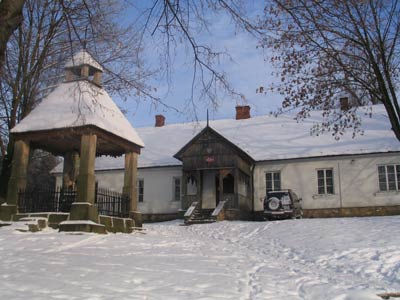Mostki (in English)
in Polish
Mostki village lies by the ?amówka river, the right tributary of Kamienna by the Parszów-Suchedniów road. You can see the remains of the blast-furnace plant here. The plant was built at Krakow’s bishops expense. The construction was started by Andrzej Za?uski and ended in 1759 by bishop Kajetan So?tyk.
Bishop Za?uski
The plant was repeatedly converted and modernized. In 1779 the two water wheels, which were moving the devices for alteration and enrichment of ore like washers and pestles, were working. Then, in 1788-89, only one water wheel was working. The plant produced salad and a casting eg: metal sheet, pegs, nozzles, pots, cauldrons, rings, grates, anvils, mortars, pans, saucers. Since 1789 the plant had been converted to the government property and then became part of the Suchedniów’s key. In 1819 the domelike furnace also called cupola furnace existed in here. In 1824-25 the plant was renovated and in 1835-36 expanded by building a new foundry with domelike furnace for casting shells. Then the 10KM steam machine made in Metal Plant in Bia?ogon was addend to the water wheel. The plant was working from time to time until 1875. Rebuilt once again in 1890 it was working until 1903. The iron ore was delivered from Dalejów, Mroczków, Parszów and Wielka Wie? ore mines. During the interwar time an object was recognized antique although it was already ruined.
You can get on the ground of the old plant by following the green markings of the trail, or from the Skar?ysko or Wykus side. The factory yard adjoining a dyke was the centre of the plant (look at the sketch).
South from the yard behind the dyke there was a pond accumulating the water which was moving water wheels. On the east side of the road to Parszów there was the administrative building. The main road was leading through the factory yard. The legible plan, ruins of the big furnace, fragments of the water intake, peebles and the old administrative building were left from the old plant. The legible outline of a pond, the earth dyke with remnants of the stone breakwater from the pond’s side, a bridge-head of the old overfall made of sandstone’s cut stones and the lower channel’s outline on the fragment parallel to the river were saved from the water intake. The broad dumps of blast-furnace’s cinder are situated on the both sides of culvert and on the ground of the yard.
On the hill, on the east side of the plant stands seen from a distance old administrative building, stoned, plastered, built on the projection of lengthened rectangle with six windows and the entrance on the axis. It was built at the begining of the 19th century and then it was rebuilt inside. It is covered with the shingle roof. Nowadays it contains well prospering Suchedniów’s Village Community Centre „Ku?nica”.
An antique roadside shrine from the end of the 19th century with St. Florian’s figure is situated in front of the entrance. St. Florian is usually shown as Roman’s officer with a vessel with water for extinguishing fire or simply extinguishing fire of houses, churches or other buildings by himself.
The two great monumental little-leaf linden grows near the building.
The outcrops of Triassic sandstones are visible at the base of a small hill.
 Gallery
Gallery(click the picture)
On the base of: Kaniewski M., 1974, Góry ?wi?tokrzyskie; S?ownik Krajoznawczy; cz. III; Studenckie Ko?o Przewodników ?wi?tokrzyskich, Warszawa
Dostarczy? i t?umaczy?: R. Sta?kowiak
Prawa autorskie © Skar?yski Wortal Turystyczny Wszystkie prawa zastrzeżone. Opublikowane: 2006-02-28 (4622 odsłon) [ Wróć ] |
















